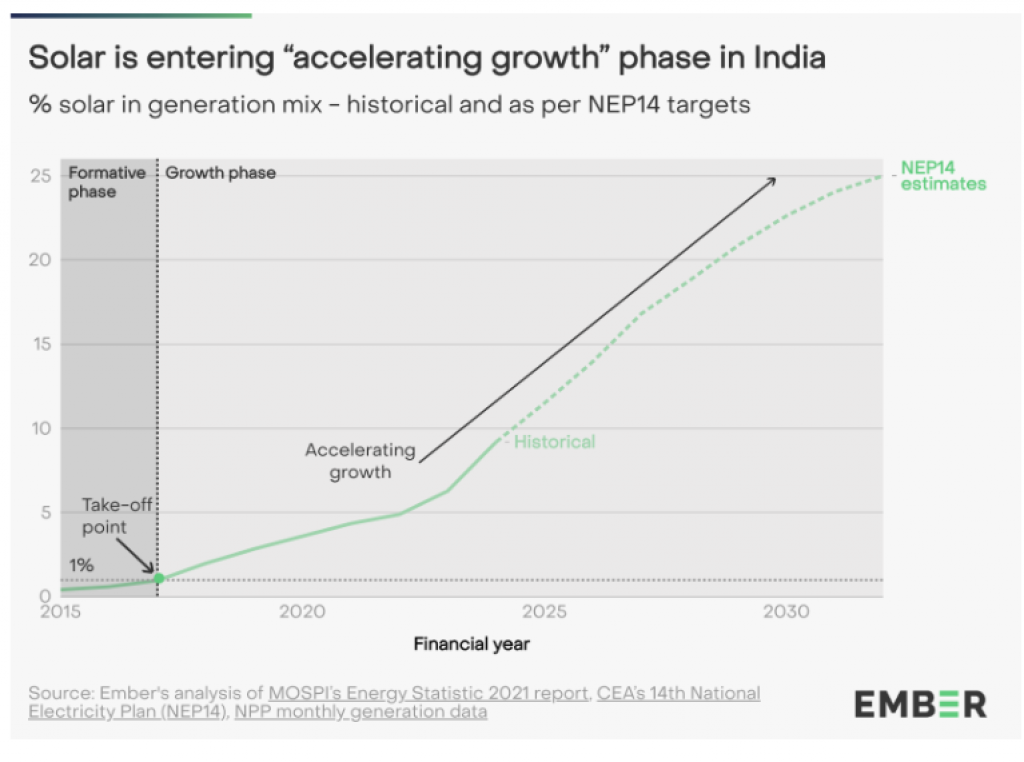

The country needs to commission a minimum of 17.5 GW in FY 2024, with a further ramp-up to 41 GW by FY 2027



India needs to increase its current annual solar capacity addition by about 36 per cent each year for the country to achieve the 14th National Electricity Plan’s targets of 185.6 gigawatts of solar capacity by the financial year 2026-27, according to a new report by global energy think tank Ember.
An addition of 12.9 gigawatts of solar capacity was commissioned this financial year, which would bring the total national solar capacity to 66.7 GW if and when completed.
However, this will still be insufficient to meet the 14th NEP’s outlined target for FY 2026-27 of 185.6 GW. So the country needs to commission a minimum of 17.5 GW in FY 2024, with a further ramp-up to 41 GW by FY 2027, the report indicated.

Beyond FY 2027, even if India continues to sustain the annual build-rate of 41 GW / year, it will surpass its target capacity of 365 GW by March 2032 by a comfortable margin, the report added on a potential route to achieve these targets.
Last year, India generated about 22 per cent of its electricity amounting to 330 terawatt-hour (TWh) from renewable energy sources, which also included large hydropower. Nevertheless, this share will almost double to 44 per cent or 1,180 TWh by 2032 if the intended capacity is added at a fast pace, the report indicated further.
Much of this will be driven by solar energy, with its share increasing from 6.3 per cent (102 TWh) in FY 2023 to 17 per cent (339 TWh) in FY2027, and then further to 25 per cent (666 TWh) in FY2032, the report stated.
In FY 2023, solar's contribution to the electricity mix saw a significant rise from 5 per cent in FY 2022 to 6.3 per cent. If the NEP14 targets are met, solar adoption is expected to enter a phase of "accelerating growth", with solar's share in the power mix rapidly increasing from 6.3 per cent in FY 2023 to 25 per cent in FY 2032, the report stated.
The expansion of variable renewable energy (VRE) will increase the demand for grid flexibility. So an area of policy that requires urgent attention is storage solutions and additional ways of enhancing grid flexibility.
“India's electricity supply landscape is projected to change quite significantly in the next decade or so, with solar and wind likely to drive the growth in generation. Given their variable nature, a significant increase in storage capacity is crucial to balance generation and demand,” Neshwin Rodrigues, Ember’s India electricity policy analyst.
A particular challenge to address is the concerns related to the under-subscription of tenders and reduced tender issuance rates.
According to an analysis by the Institute of Energy Economics and Financial Analysis, VRE tenders issued annually in India had drastically reduced from 40 GW in 2019 to nearly 28 GW in 2022. The reasons are that distribution companies are under financial duress and the cost of solar modules is rising.
Solar tariffs rose from Rs 1.99 per kWh in 2020 to Rs 2.51 in Q1 2023 due to disruptions in the supply chain and higher Goods and Services Tax rates. There are also insurance costs and the customs duties to contend with, the Ember report explained.
“Additionally, the reinstatement of the Approved List of Models and Manufacturers after its suspension until March 2024 may lead to a rise in costs. This list confines participation in government-bid solar development projects to specific indigenous models and manufacturers,” the report said.
NEP14 estimated that India’s total annual electricity generation will reach 1,174 TWh during 2022-32. Annual solar and wind generation is expected to rise by 593 TWh and 189 TWh respectively, which combined constitute 66 per cent of India's power generation growth in this 10-year period. “This marks a significant transition from the preceding decade when coal power accounted for around 80 per cent of generation growth,” the report added.
We are a voice to you; you have been a support to us. Together we build journalism that is independent, credible and fearless. You can further help us by making a donation. This will mean a lot for our ability to bring you news, perspectives and analysis from the ground so that we can make change together.

Comments are moderated and will be published only after the site moderator’s approval. Please use a genuine email ID and provide your name. Selected comments may also be used in the ‘Letters’ section of the Down To Earth print edition.